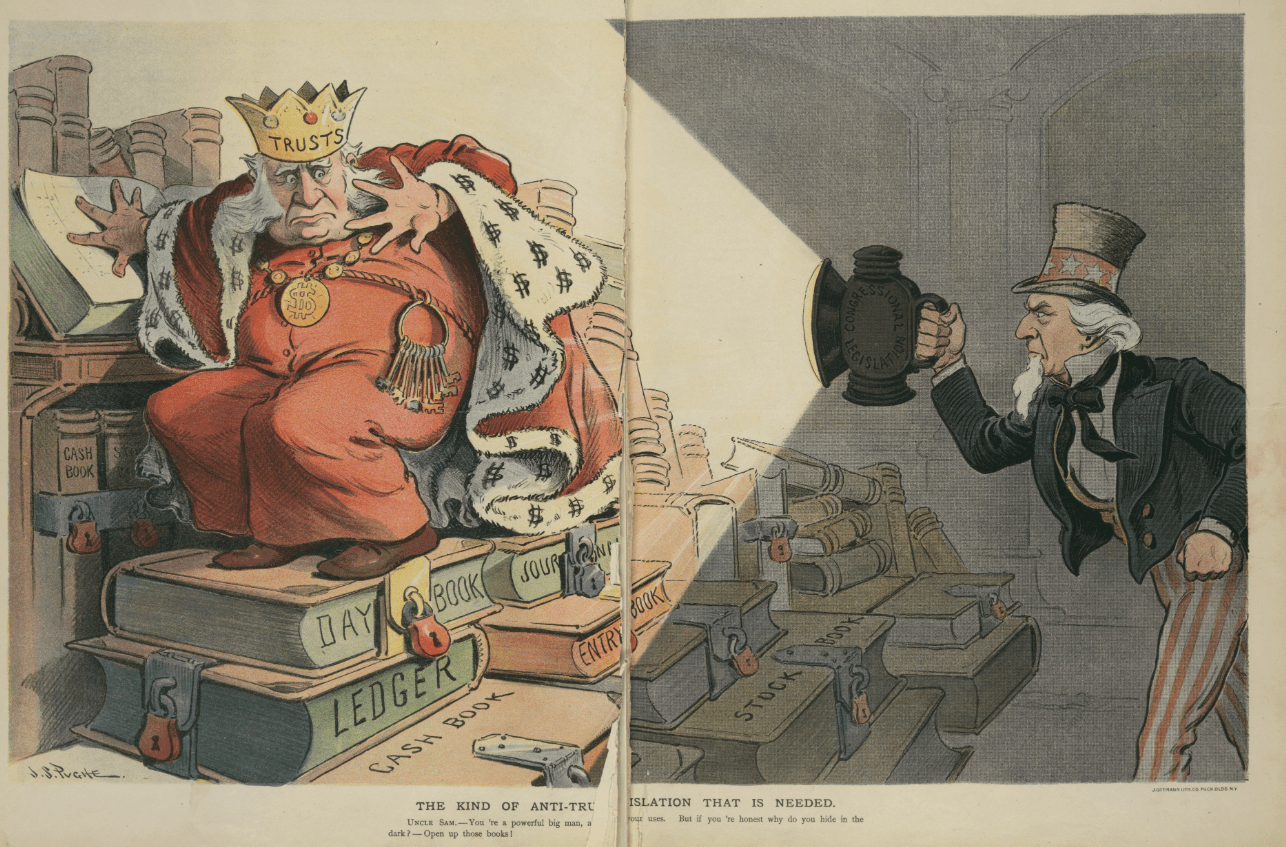
Source:Wikimedia
Antitrust Laws in the U.S. and Their Enforcement
The antitrust laws in the United States officially began in 1890 to promote fair trade and regulate market competition. According to the Federal Trade Commission (FTC), the goal of any antitrust law is to protect consumers against unfair pricing practices by encouraging competition among businesses and by ensuring that businesses “operate efficiently, keep prices down, and keep quality up” (n.d.). These laws are enforced by the Antitrust Division of the Justice Department and the FTC.
At the time of the Sherman Act in 1890, monopolies were referred to as “trusts.” Antitrust laws arose to prevent these monopolies and attempts to monopolize. Multiple acts have been enacted since, most importantly the Clayton Act of 1914 and the Federal Trade Commission Act of 1914. Together, these laws prevent businesses from gaining horizontal control over their markets, in which they own or control their competition, and vertical control, in which they own or control their supply chain.
Sherman Act of 1890
Named after Senator John Sherman, the Sherman Act of 1890 prohibits “every contract, combination, or conspiracy in restraint of trade,” and any “monopolization, attempted monopolization, or conspiracy or combination to monopolize,” as it appears in the National Archives. According to the FTC, “the Supreme Court decided that the Sherman Act does not prohibit every restraint of trade, only those that are unreasonable” (n.d.). This is known as the rule of reason. However, also according to the FTC, there are several violations of the Sherman Act that are always unreasonable and for which there is no justification, known as “per se” violations (n.d.).
As found in the National Archives, the Sherman Act is written in eight sections: Sections 1 and 3 outlaw monopolies; Section 2 declares the forming of such contracts to be a misdemeanor; Section 4 gives U.S. circuit courts the power to enforce the act; Section 5 gives the courts the power to summon and serve subpoenas to enforce the act; Section 6 makes any property owned by illegal monopolies being transported internationally or over state lines the property of the U.S. government; Section 7 gives people who are economically injured by illegal monopolies the right to sue the business for treble damages; lastly, Section 8 defines “person” to include corporations that exist under U.S. laws (1890).
Clayton Act of 1914
The Clayton Act was passed in 1914 to strengthen the Sherman Act. While the Sherman Act outlaws the creation of monopolies, the Clayton Act outlaws actions that show the intention to create monopolies. According to the Legal Information Institute at Cornell Law School, it was enacted to prohibit price discrimination, requirements of exclusivity for sales, mergers, and acquisitions that “substantially reduce competition,” and one person serving on the board of directors for two companies that are in competition (n.d.). A notable aspect of the Clayton Act is that it exempts labor unions, while the Sherman Act did not.
The FTC notes that the Clayton Act was amended by the Robinson-Patman Act of 1936 “to ban certain discriminatory prices, services, and allowances in dealings between merchants” and in 1976 by the Hart-Scott-Rodino Antitrust Improvements Act “to require companies planning large mergers or acquisitions to notify the government of their plans in advance” (n.d.).
Federal Trade Commission (FTC) Act of 1914
The Federal Trade Commission Act of 1914 established the FTC as a regulatory agency and expanded the scope of the antitrust laws. As the text appears on GovInfo, the act prohibits “unfair methods of competition” and “unfair or deceptive acts or practices in or affecting commerce” (1914). The notable section of the FTC Act is Section 5, which gives the FTC the authority to investigate and prevent the prohibited practices above through injunctions (1914). The goal is to protect both a fair, competitive market and protect that market’s consumers.
The first sections of the FTC Act discuss the creation of the FTC and its scope of power (1914). According to the FTC, although the FTC does not directly enforce the Sherman Act, the FTC can bring cases of violations of the Sherman Act under the FTC Act because all violations of the Sherman Act also violate the FTC Act (n.d.).
Sanctions for violations
The penalties for violating antitrust laws depend on which act the business violates. The laws are enforced by both the FTC and the DOJ’s Antitrust Division.
When businesses violate the Sherman Act, they can face both civil and criminal charges. According to the FTC, criminal penalties can involve “up to $100 million for a corporation and $1 million for an individual, along with up to 10 years in prison”; the fines can go up to twice the amount that the people lost who were harmed by the practices (n.d.).
According to the Legal Information Institute, violations of the Clayton Act are always civil with no criminal charges; people who are impacted by these violations can sue businesses for an injunction and triple the amount that they lost (n.d.). The FTC notes that the Clayton Act gives people the ability to obtain a court order when they have been harmed by violations of the Sherman Act as well (n.d.).
Looking ahead
As the intention of the antitrust laws is to protect consumers and the fair market by preventing and stopping unfair and anticompetitive business practices, the laws are updated according to the evolving market. The acts are regularly either supported or challenged by supreme court cases, and both the FTC and the DOJ regularly present updates. Last year, the DOJ presented updates to merger guidelines in response to public opinions (2023). These updates ensure that the antitrust acts and their powers stay current and relevant to the modern economy.
